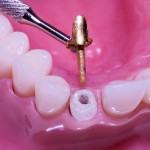
The ferrule effect is considered an important factor influencing the clinical outcome of endodontically treated teeth as the remaining dental structure is often fragile as a result of root canal treatment.
The aim of this review was to assess laboratory and clinical studies to evaluate the effect of ferrule in restored endodontically treated teeth.
Methods
Searches were conducted in Medline and Scopus databases with no limits on publication date on language. Clinical and in vitro studies that evaluated the effect of a ferrule in restored endodontic teeth were considered. Study selection was carried out independently by two reviewers, I reviewer extracted data with checking by a second reviewer. Risk of bias was assessed.
For laboratory studies, a meta-analysis was performed for the comparison of the fracture resistance of teeth with and without ferrule, and 3 subgroup analyses were conducted for ferrule height, post type, and type of tooth. For clinical studies, the Kaplan-Meier method was used to determine the survival of restorations, with log-rank test used to identify differences between groups
Results,
- 32 in vitro studies and 5 prospective clinical studies were included
- in vitro studies,
- 6 used bovine teeth 10, human posterior teeth; and 16, anterior human teeth
- The ferrule group presenting a higher fracture resistance versus the groups without a ferrule Mean Difference (MD) = –213.92; (95%CI; –247.09 to –180.75;
- Teeth with ferrule showed a higher fracture resistance when compared with teeth without ferrule for metal posts, MD= –245.01; (95% CI; –299.13 to –190.88) and non-metal posts MD = –185.97; (95% CI; –225.35 to –146.59),
- A ferrule also increased fracture resistance for anterior, MD= –229.05; (95% CI: –285.74 to –172.36) and posterior teeth, MD= –182.21; (95% CI: –232.94 to –131.49 .
- Clinical studies
- Teeth with ferrules presented higher longevity when compared with teeth without ferrules, for both tooth survival (P = 0.002) and restoration survival (P < 0.0001).
- Premolars with ferrules showed higher survival (P = 0.05), while molars and anterior teeth did not present statistically significant differences
Conclusions
The authors concluded
The presence of a ferrule is responsible for an improvement in the fracture resistance of the restoration in laboratory studies. Yet, other clinical factors besides the ferrule may be associated with survival in molars and anterior teeth and need to be further investigated.
Comments
This review is limited to 2 databases so there is a possibility that some studies may not have been included. While the review does demonstrate a positive effect for survival with the ferrule it is important, as the authors note, that the data comes mainly from in vitro studies. While the small number of clinical studies also suggest a lower failure rate with a ferrule additional clinical data would be helpful as other clinical factors may be associated with improved clinical outcomes.
Links
Primary paper
Skupien JA, Luz MS, Pereira-Cenci T. Ferrule Effect a meta-analysis. JDR Clin & Trans Res Apr 2016: 1 p 31-39

Ferrule effect improved outcomes in endodontically treated teeth? https://t.co/8ZehKn654W
Lab studies suggest ferrule improve outcomes in endodontically treated teeth https://t.co/8ZehKn654W
Ferrule improved outcomes in endodontically treated teeth suggests review
https://t.co/8ZehKn654W
Root treated teeth with ferrules had higher fracture resistance suggest review
https://t.co/8ZehKn654W
Don’t miss- Ferrule effect improved outcomes in endodontically treated teeth? https://t.co/8ZehKn654W
Great paper!!! Murilo Luz Tatiana Cenci